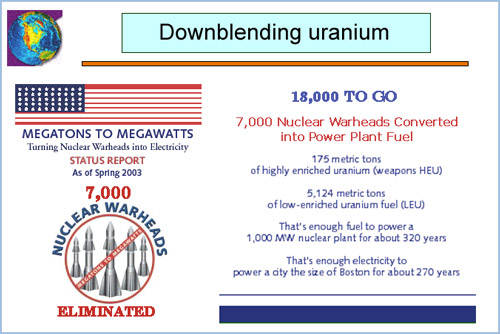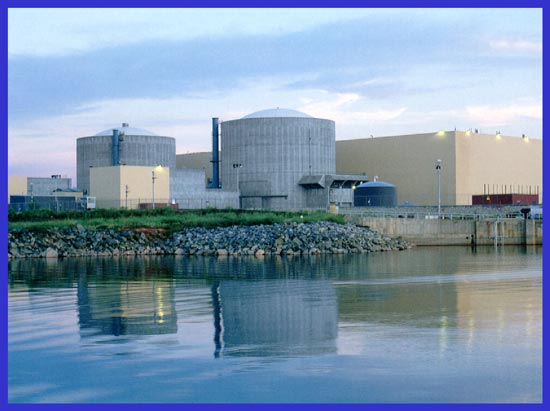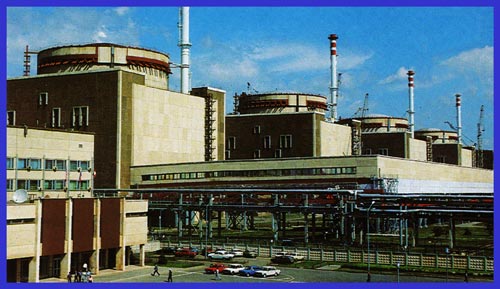A modest step towards a reduction in nuclear arsenals
During the Cold War, the United States and the USSR – the two rival superpowers – amassed between them enough thousands of atomic bombs to destroy all life on Earth several times over. Compared to such apocalypse, the hazards of radioactivity seem marginal.
Before the collapse of the Berlin Wall in 1990, this terrifying prospect had brought the two rival superpowers to sign agreements to reduce their arsenals. The United States and Russia, the heir of the former USSR, have agreed that their weapons-grade materiel in excess of the estimated needs of their national defence should be converted into fuel to be burned in civilian reactors.

Downblending highly enriched uranium (HEU)
The US Enrichment Corporation has the American sense of formula. It regularly kept the public informed about the status of 500 tons of surplus Russian military uranium slated for downblending. In spring 2003, 175 tons – the equivalent of 7,000 nuclear warheads – had been already destroyed, the equivalent of 7,000 nuclear warheads, enough to supply a reactor of 1000 megawatts for 320 years and provide electricity to a Boston for 270 years.
© USEC
In order to reduce the nuclear menace, the first step is to dismantle the warheads in excess and their missile launchers. Substantial efforts along the lines of the START1 and START2 treaties have been made to eliminate these “vectors” that can reach the enemy with their bombs, and the silos where these weapons were stored. Owing to the state of dereliction of the Russian economy during the Boris Yeltsin years, the Americans even helped finance their disarmament through the Nunn-Lugar initiative.`

USA: Destruction of weapons-grade fissile materials
American supplies of highly enriched uranium and weapons-grade plutonium that have been classified as ‘surplus’ will be converted into reactor fuel that can power America’s commercial reactors.
DOE
The START treaties were updated in 2010. The last treaty now ratified by the United States and Russia, is valid for ten years and renewable for five years. It that each country can not deploy more than 1,550 warheads, a reduction of 30% over 2002.
However as long as the fissile material that makes up the warheads is not destroyed, there is still the possibility to reuse it in order to make new bombs. The crucial step is therefore to eliminate the explosive of the warheads, the weapons-grade uranium and plutonium.
Although the material defined as ‘surplus’ by Russia and the United States only account for a fraction of their nuclear arsenals, their elimination involves the destruction of several thousands bombs. This partial dismantling is however a lengthy procedure, and will take far longer than the man on the street would wish. The critical mass, the mass of fissile material necessary to make an atomic bomb, is only 50kg of uranium 235 and 17kg of plutonium 239 for a naked sphere. If there is a reflector of neutrons, the critical mass is even less.

Russia : burning of weapons-grade plutonium
Russian surplus plutonium will be converted into MOX fuel to power Russian nuclear reactors.
© DOE
This is nonetheless a giant step in the right direction, and one can only hope that future generations will accelerate the movement.
The weapon-grade uranium is an highly enriched uranium (UHE), containing more than 90% of the fissile 235 isotope. Is destruction is fairly easy : all that needs to be done is to dilute thz so painfully enriched uranium with quantities of natural uranium. In the case of weapos-grade plutonium, natural plutonium does not exist in nature. It is impossible to dilute plutonium 239, but it is possible to include weapos-grade plutonium in the nuclear fuel of a reactor. Once burned inside a civilian reactor., the material has become unsuitable for weapon production.
The destruction of highly-enriched uranium, by far the simplest, has been underway since 1994. When the current programme reaches its end, 500 tons of Russian and 174 tons of American weapons-grade uranium will have been destroyed.
The US-Russian stockpile of weapons-grade plutonium has been estimated at around 260 tons. Out of this total, the two Cold War adversaries have each agreed to destroy 34 tons of declared surplus, which will be recycled in the form of MOX fuel and reused by civilian reactors. Two installations able to fabricate MOX fuels from weapons-grade plutonium should be built in the United States and in Russia. The effective elimination of U.S. surplus plutonium was scheduled to begin in the 2008-2010 at the rate 2 tons per year.
In a discourse made in Berlin in june 2013, President Obama proposed to President Putin of Russia a further reduction to 1000 of the number of warheads.
With the war in Ukrain in 2022, this reduction is unfortuntely stopped.
Other articles on the subject « Military Applications »
Nuclear Weapons
Atomic and thermonuclear bombs There are two types of nuclear bombs: the atomic A bombs and the t[...]
The 1945 A-bombs
Little Boy and Fatman The United States had available three bombs in July 1945: two made of pluto[...]
The Franck Report
The Scientists who opposed dropping atomic bombs on Japan In June 1945, shortly before the atomic[...]
Nagasaki
A Japanese account of the Nagasaki bomb Atomic bomb, rescue and relief report, a poignant small b[...]
Nagasaki First Aid
Extracts from Doctor Takashi Nagai first report In this first rescue report intended for the auth[...]
Atoms for Peace
1953: Eisenhower’s initiative for peaceful use of the atom After the Second World War, The [...]
Testing Nuclear Weapons
A practice that culminates in the 1950’s and 1960’s… The nuclear tests conducted by the sup[...]
Atomic Tests Fallout
An embarrassing legacy but alleviated with time Radioactive fallout differ significantly accordin[...]